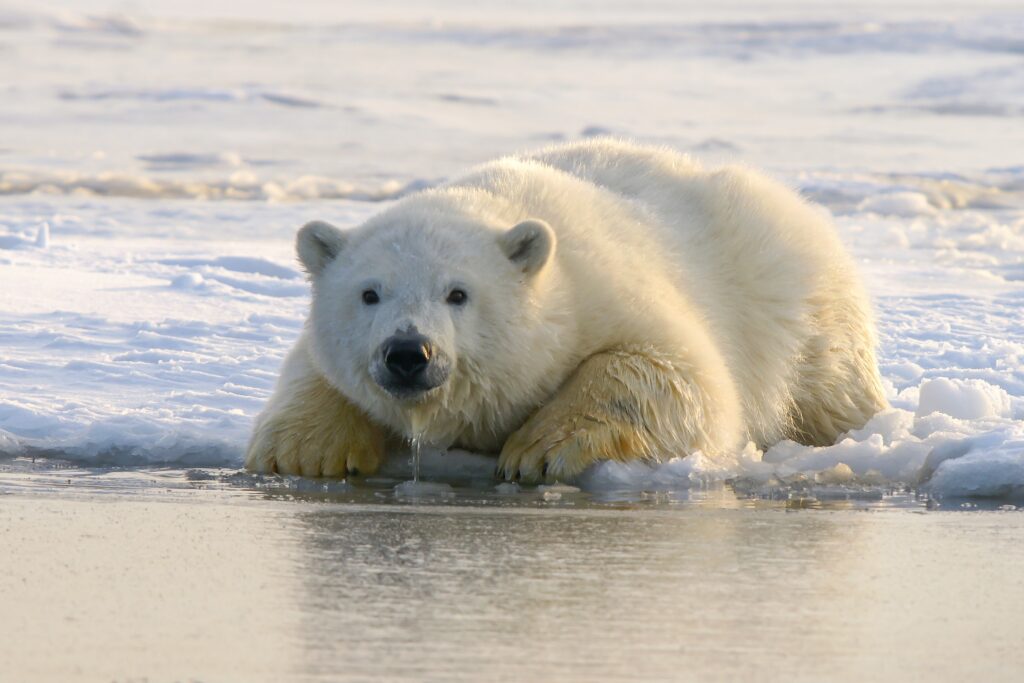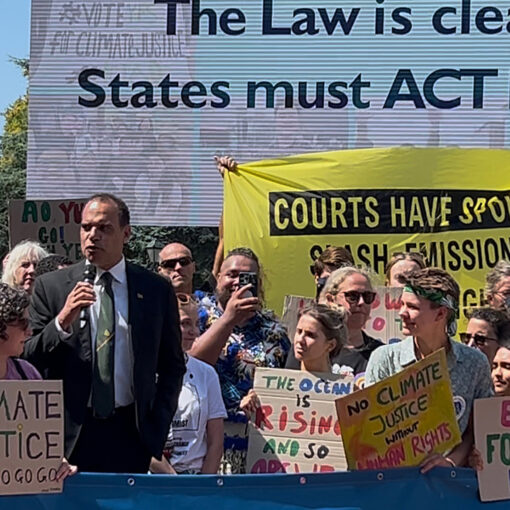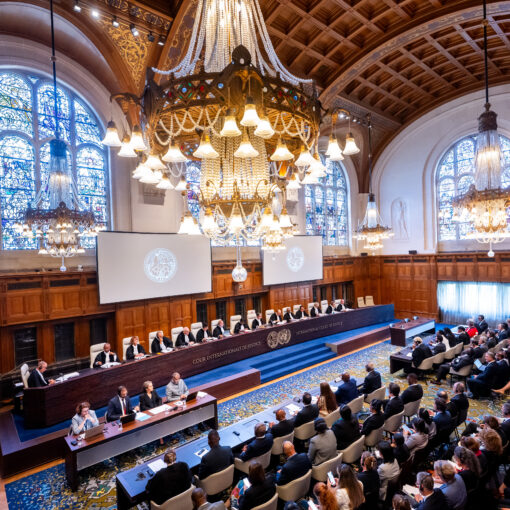
In November, a judge in the U.S. District Court for the District of Alaska dismissed two lawsuits filed by environmental organizations and an indigenous Iñupiat group seeking vacatur of the Biden administration’s approval of the Willow oil and gas project. As we have detailed in previous blog posts, the Willow project has garnered considerable controversy due to its size and location: the project involves the construction of up to 199 new oil wells and associated infrastructure in the North Slope of Alaska, the largest undisturbed track of public land in the United States. The Bureau of Land Management (BLM) estimates that it will produce 576 million barrels of oil over its 30-year lifetime, resulting in more than 239 million metric tons of carbon dioxide (CO2)-equivalent. The Biden administration’s approval of the project appears to contravene President Biden’s campaign promise to stop oil drilling on federal lands.
One of the claims raised by plaintiffs was that BLM and the Fish and Wildlife Service (FWS) violated the Endangered Species Act (ESA) by failing to adequately assess whether greenhouse gas (GHG) emissions from the Willow project could affect survival and recovery prospects for ice-dependent species, specifically polar bears, Arctic ringed seals, and bearded seals. The Sabin Center submitted an amicus brief supporting this claim and explaining how climate change attribution and detection research can be used to assess the effect of project-level emissions on sea ice declines within the habitat ranges of these species.
The court held that BLM and FWS could lawfully exclude GHGs from their ESA jeopardy analysis because the emissions were not “reasonably certain” to “effect listed species or critical habitat” in the “Action Area” and thus did not qualify as “effects” within the meaning of the ESA. (Decision at 101-102.) BLM’s determination that GHG effects were not “reasonably certain to occur” was based on a memorandum in which it stated that it could not “quantify potential impacts” and “determine precise effects to individual animals” based on the “marginal” quantity of sea ice loss attributable to project-level emissions. (Decision at 100.)
As detailed below, there are at least two potential errors underpinning the court’s decision on this issue. First, the “Action Area” for ESA jeopardy analyses encompasses all areas that are directly or indirectly affected by the project, and thus cannot serve as a constraint on the effects analysis. Second, there is robust scientific evidence of the link between greenhouse gas emissions, rising temperatures, and declining sea ice. It is almost certainly true that emissions from the Willow project will contribute to the loss of sea ice that polar bears and seals depend upon for their survival. Allowing a federal agency to ignore this effect because it cannot be measured with precision (e.g., at the level of an individual animal) contradicts both the conservation purpose of the ESA and the plain meaning of what qualifies as a “reasonably certain” effect.
Section 7 Consultations and the Willow Project
Section 7 of the ESA requires federal agencies to ensure that the projects they implement, fund, or authorize will not jeopardize the continued existence of any species that is listed as endangered or threatened. This is accomplished through scientific consultation with FWS and/or the National Marine Fisheries Service (NMFS), depending on which service has jurisdiction over the relevant species. (FWS has jurisdiction over terrestrial and freshwater species and NMFS has jurisdiction over marine species.)
Section 7 consultations are required for any federal actions that “may affect” a listed species or its critical habitat. The process typically begins with informal consultation and publication of a Biological Assessment (BA) by the lead agency (i.e., the one implementing, funding, or authorizing the action). If the BA determines that the action is “likely” to affect a listed species, the consulting service(s) must then publish a more detailed Biological Opinion (BiOp) describing the effects of the project on listed species and the measures that the federal agency is taking to ensure the action is not likely to jeopardize affected species.
The ESA regulations define the “effects” that must be considered in the BiOp:
“Effects are all consequences to listed species or critical habitat that are caused by the proposed action, including the consequences of other activities that are caused by the proposed action. A consequence is caused by the proposed action if it would not occur but for the proposed action and it is reasonably certain to occur. Effects of the action may occur later in time and may include consequences occurring outside the immediate area involved in the action.” 50 C.F.R. § 402.02
An action is considered to cause “jeopardy” to a species if it “reasonably would be expected, directly or indirectly, to reduce appreciably the likelihood of both the survival and recovery of a listed species… by reducing the reproduction, numbers, or distribution of that species.” 50 C.F.R. § 402.02. The jeopardy analysis must be based on the best available scientific data. ESA § 7(a)(2). A federal agency cannot proceed with an action that would cause jeopardy unless the project receives an exemption from a special committee of cabinet officials known as the “God Squad.”
Recognizing that the Willow Project had the potential to affect ESA-listed species, BLM entered into a Section 7 consultation with both FWS and NMFS, which culminated in the publication of a BA in August 2022 and a BiOp in January 2023. Although the BA and BiOp both recognized that sea ice loss from climate change was the greatest threat to polar bears that would be affected by the project, neither contained any discussion of GHG emissions attributable to the project and their contribution to sea ice loss. As detailed in a previous blog post, the decision to exclude GHG emissions from the BA and BiOp can be traced to a 2008 legal opinion known as the Bernhardt Memorandum which stated that project-specific GHG emissions could not pass the “may affect” test and thus GHG emissions were “not subject to consultation under the ESA and its implementing regulations.”
After BLM published the BA and draft environmental impact statement (DEIS) for the project, it received multiple comments urging it to consider the effect of GHG emissions in its jeopardy analysis. The Center for Biological Diversity (CBD), one of the plaintiffs in the Willow case, directed BLM to a study that quantified the incremental contribution of CO2 emissions to sea ice loss. Specifically, Notz & Stroeve (2016) found that each metric ton of CO2 results in a sustained loss of 3 ± 0.3 square meters of September sea-ice. Based on this research, one could estimate that the emissions attributable to Willow (239 million metric tons CO2-equivalent) will result in the loss of approximately 717 million square meters (717 km2) of September Arctic sea ice. This would be equivalent to an area more than twelve times the size of Manhattan, or parking spaces for nearly 60 million cars. It is considerably larger than the habitat loss directly resulting from construction of infrastructure for the Willow project (e.g., the BiOp estimates 2.20 km2 of spectacled eider habitat would be destroyed by roads, pads, boat ramps, access roads, an air strip, and excavation of a mine site; there is no such estimate for polar bear habitat).This sea ice estimate may need to be adjusted to account for the different effects of methane and other emissions included in the estimate of CO2-equivalent emissions from Willow – the point is that methods do exist for making these types of calculations, and the scale of attributable sea ice loss is even greater than the scale of habitat loss discussed in the BiOp.
BLM consulted informally with FWS on this matter. In a 2-page document, BLM concluded that the “sea-ice calculation is too broad to quantify potential impacts to listed species” and their critical habitat, and therefore it was unable to ascertain whether a “marginal” reduction in sea ice loss in the Arctic would cause any effect whatsoever to the species. Only two days after it received this document from BLM, FWS provided its concurrence, agreeing that climate science was “insufficient to identify project-specific effects to listed species or designated critical habitat.”
BLM and FWS Impermissibly Excluded GHG Effects from the Section 7 Consultation Because They Were “Marginal” and Could not Be “Quantified” or Measured with “Precision”
The exchange between BLM and FWS reveals that their reasons for excluding GHG effects from the BiOp and BA were that: (i) the sea ice loss attributable to Willow’s emission would be “marginal”, and (ii) it was not possible to “quantify” or measure the effect of sea ice loss on species with “precision” due to variables such as, e.g., the non-linear relationship between sea ice loss and impacts on listed species. However, these findings do not support BLM and FWS’s decision to wholly exclude GHG emissions from the Section 7 consultation documents.
As noted above, the ESA regulations require federal agencies to consider any effects that are “reasonably certain to occur” as a result of the action. This includes both direct and indirect effects. There is no provision in the regulations which allows an agency to wholly ignore effects simply because they are small, unquantifiable, or cannot be measured with precision. Rather, the consultation process is used to evaluate the magnitude of the effect, even if it is relatively small.
The ESA Consultation Handbook discusses how magnitude should be addressed in ESA consultations. An agency may conclude that impacts are “not likely to adversely affect” a species if they are: (i) “discountable”, i.e., “extremely unlikely to occur”, or (ii) “insignificant”, i.e., “a person would not be able to meaningfully measure, detect, or evaluate insignificant effects.” But such determinations are made during consultation and require written concurrence from the FWS and/or NMFS. Moreover, the FWS guidelines state that a project is “likely to adversely affect” a listed species if it will adversely affect even one individual of the species. Thus, the guidelines clarify that even small effects should be considered during consultation.
Climate change detection and attribution research has demonstrated a robust and direct relationship between GHG emissions, rising temperatures, and sea ice loss. The latest IPCC Assessment (AR6) found, with very high confidence, that sea ice extent has declined since 1979 in each month of the year, with the largest declines occurring in the summer, and that summer sea ice is declining most rapidly in the East Siberian, Beaufort, Chukchi, Laptev, and Kara seas. These regions overlap with the designated critical habitat for polar bears, ringed seals, and bearded seals. IPCC AR6 also found that reductions in Arctic sea ice extent scale linearly with both global temperatures and cumulative CO2. Because of this linear relationship, it is possible for researchers like Notz & Stoeve to generate estimates of sea ice loss per unit of CO2 emitted.
The loss of sea ice has been directly linked to population declines, range contractions, phenological shifts, and other changes in the distribution, demographics, physiology, denning, foraging behavior, and survival rates for polar bears. For example, reductions in summer sea ice and later arrival of autumn sea ice have been linked to nutritional deficits as well as lower body mass in adult females and their cubs during the denning season. Less sea ice also means that bears must swim longer distances, which poses a drowning risk to young cubs. See, e.g.,IPCC AR6 WGI Ch.3; Laidre et al. (2018); Tartu et al. (2018); Aars et al. (2017); Lunn et al. (2016); Derocher et al. (2011); Regehr et al. (2010). There is also research on the adverse effects of sea ice loss on seals and other ice-dependent species. See, e.g., Ferguson et al. (2017); Laidre et al. (2015).
Thus, there is a clear causal connection between the emissions attributable to the Willow project, sea ice loss, and adverse effects on species. BLM maintains that it cannot “pinpoint” the location of those effects; however, GHG emissions are well-mixed in the atmosphere, and thus the emissions from Willow will foreseeably contribute to a portion of sea ice loss across all regions where it is occurring. It can therefore be argued that the effect on those species from GHG emissions is “reasonably certain to occur” even if the effect is relatively small or unquantifiable.
Ultimately, it appears that BLM’s conclusion about the foreseeability of impact was primarily based on its view that the attributable sea ice loss was “marginal.” The problem with BLM’s approach is that it conflates foreseeability with magnitude. The question of magnitude should be addressed through normal Section 7 consultation procedures.
Federal Agencies Cannot Ignore Effects Because They Fall Outside of a Predefined “Action Area”
In upholding BLM and FWS’s decision to exclude GHG emissions from the BiOP and BA, the court specifically found that this was proper because the scientific evidence did not show a “reasonably certain decrease in sea ice impacting polar bears in the Action Area.” (emphasis added). It appears that the court applied an incorrect standard, as the predefined Action Area that was used in the BiOp and BA has no bearing on whether or not it was proper for BLM and FWS to exclude GHG emissions.
The ESA regulations require federal agencies to consider how the federal action will affect baseline environmental conditions within the “action area”, which is defined as “all areas to be affected directly or indirectly by the Federal action and not merely the immediate area involved in the action.” 50 C.F.R. § 402.02.
The action area must therefore be established based on the geographic scope of effects. It would be impermissible for a federal agency to predefine an Action Area and then omit otherwise foreseeable effects from its analysis simply because they fall outside of that Area. See Nat’l Wildlife Fed’n v. Nat’l Marine Fisheries Serv., 254 F. Supp. 2d 1196, 1212 (D. Or. 2003) (finding that NOAA’s defined “action area” was unreasonably narrow because it excluded areas where project impacts were “perhaps less direct but no less certain to occur”). See also Oregon-California Trails Ass’n v. Walsh, 467 F. Supp. 3d 1007, 1050 (D. Colo. 2020) (“Indirect (and direct) effects are not constrained by the action area—they are the action area.”)
In the case of Willow, BLM and FWS defined an Action Area based on local effects – it did not reflect the geographic scope of GHG effects because those effects were excluded from the analysis. This kind of closed loop, circular reasoning is inappropriate when addressing the impacts of a massive fossil fuel project.
The 2008 Bernhardt Memorandum Should be Repealed
BLM is not unique in its decision to exclude GHG emissions from its ESA consultation for Willow. This is standard practice among federal agencies, and it can be traced back to the Bernhardt Memorandum, which concluded that agencies were not required to consider GHG emissions during ESA consultations because it would be impossible to establish a causal link between GHG emissions, global climate change, and specific localized effects on species and their habitat. The memo also assumed that any effects attributable to a particular project would be “too small to physically measure or detect.”
Contrary to the position adopted in that memo, there are scientific methods and data that can be used to evaluate the causal nexus between project-level GHG emissions, global climate change, and impacts to species and habitats. Some GHG impacts, such as sea ice loss, are plainly foreseeable and should not be wholly ignored during Section 7 consultations, particularly consultations for fossil fuel leases and other projects that generate substantial quantities of GHG emissions. As illustrated in this discussion of Willow, the GHGs attributable to a project may actually have a larger impact on a listed species’ habitat than other types of impacts that are routinely addressed in Section 7 consultations (e.g., the direct loss of habitat from project infrastructure). Given these considerations, federal agencies should: (i) initiate Section 7 consultations for large fossil fuel leasing projects, as the emissions from these projects clearly pass the “may affect” test; and (ii) use the consultation process to evaluate whether project-specific GHG effects could “appreciably diminish” habitat values or otherwise cause jeopardy to ESA-listed species.

Jessica Wentz
Jessica is now a non-resident senior fellow at the Sabin Center.




